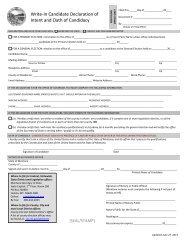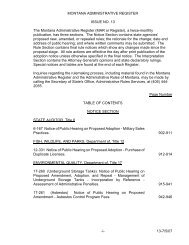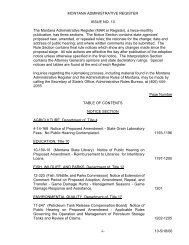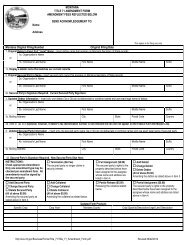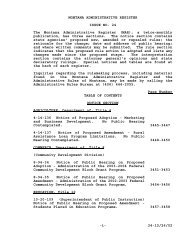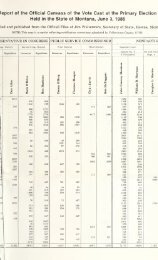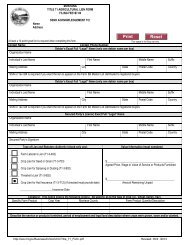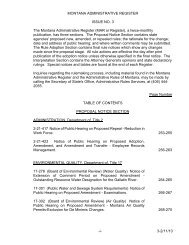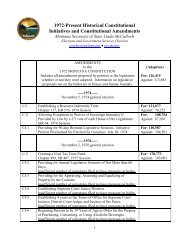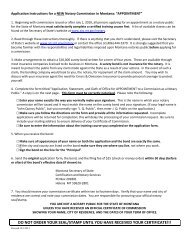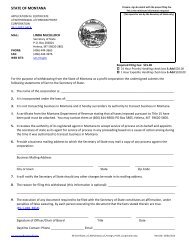Notary Handbook - the Montana Secretary of State Website
Notary Handbook - the Montana Secretary of State Website
Notary Handbook - the Montana Secretary of State Website
Create successful ePaper yourself
Turn your PDF publications into a flip-book with our unique Google optimized e-Paper software.
CHAPTER 6 - COMPLETING PROPER NOTARIAL BLOCKS<br />
You’ve completed all <strong>the</strong> requirements, you’ve received your<br />
Certificate <strong>of</strong> Commission, you have your stamp and your journal –<br />
you’re ready to go forth and notarize…<br />
But you’d really like a little more information about how to recognize<br />
what type <strong>of</strong> notarization you should perform and how to complete<br />
<strong>the</strong> notary block? That’s what this chapter is here for. On <strong>the</strong> next<br />
few pages, <strong>the</strong>re will be examples <strong>of</strong> various situations and notarial<br />
blocks that you are likely to have presented to you and explanations<br />
<strong>of</strong> <strong>the</strong> proper way to complete <strong>the</strong>m.<br />
First <strong>of</strong> all, <strong>the</strong>re are nine elements required for every notarial block<br />
completed by a <strong>Montana</strong> notary public. As a notary you are<br />
required by law to include every single one <strong>of</strong> <strong>the</strong>se items in every<br />
notarial block you complete – even if <strong>the</strong> preprinted form on <strong>the</strong><br />
document does not call for it.<br />
As ministerial <strong>of</strong>ficials, notaries cannot<br />
determine what type <strong>of</strong> notarial act is<br />
required on a document; <strong>the</strong>y must look<br />
to <strong>the</strong> preprinted wording on <strong>the</strong> notarial<br />
block, <strong>the</strong> author or creator <strong>of</strong> <strong>the</strong><br />
document, or <strong>the</strong> customer for<br />
instruction as to what type <strong>of</strong> block is<br />
required.<br />
A notary may never change <strong>the</strong> type<br />
<strong>of</strong> notarial act that is specified in <strong>the</strong><br />
notarial block.<br />
****************[The first four elements describe <strong>the</strong> specifics <strong>of</strong> <strong>the</strong> particular notarization.]**********<br />
1. The venue - this is <strong>the</strong> state and county where <strong>the</strong> notarization is performed. This is not always <strong>the</strong> state and<br />
county in which <strong>the</strong> notary resides or works. See “Jurisdiction” on page 2.<br />
2. The date when <strong>the</strong> notarization was performed. This may not always be <strong>the</strong> same date that <strong>the</strong> document was<br />
completed and/or signed.<br />
3. A written description <strong>of</strong> what type <strong>of</strong> notarial act <strong>the</strong> notary performed including <strong>the</strong> name <strong>of</strong> <strong>the</strong> person for<br />
whom <strong>the</strong> notarization was performed. This is called <strong>the</strong> “<strong>State</strong>ment <strong>of</strong> Particulars.” The notary may need to refer to<br />
1-5-610, MCA, or Chapter 6 <strong>of</strong> this notary handbook, to help with <strong>the</strong> wording and format.<br />
4. The notary's <strong>of</strong>ficial signature in blue or black ink, not a facsimile <strong>of</strong> <strong>the</strong>ir signature. The <strong>of</strong>ficial name on <strong>the</strong><br />
Notarial Seal and <strong>the</strong> notary's <strong>of</strong>ficial signature must correspond with <strong>the</strong> notary's commissioned name on file with<br />
<strong>the</strong> Office <strong>of</strong> <strong>the</strong> <strong>Secretary</strong> <strong>of</strong> <strong>State</strong>.<br />
**********[The following information identifies <strong>the</strong> notarial <strong>of</strong>ficer and validates <strong>the</strong> notarization.]******<br />
5. The notary must type, stamp or print <strong>the</strong>ir <strong>of</strong>ficial name legibly after<br />
<strong>the</strong>ir <strong>of</strong>ficial signature. This is in addition to <strong>the</strong>ir <strong>of</strong>ficial name contained<br />
in <strong>the</strong>ir notarial seal. (The notary’s name should appear three times on<br />
every notarial block.)<br />
6. Title <strong>of</strong> <strong>the</strong> <strong>of</strong>ficial who is performing <strong>the</strong> notarial act. If a<br />
commissioned notary it would be "<strong>Notary</strong> Public for <strong>the</strong> <strong>State</strong> <strong>of</strong><br />
<strong>Montana</strong>". If not a commissioned notary, it would be <strong>the</strong> <strong>of</strong>ficial title<br />
that gives <strong>the</strong>m <strong>the</strong> authority to notarize documents in and for <strong>the</strong> <strong>State</strong><br />
<strong>of</strong> <strong>Montana</strong>.<br />
7. The words "residing at" and <strong>the</strong> notary's city/town <strong>of</strong> residence. This is<br />
not necessarily where <strong>the</strong> notary works or where <strong>the</strong> notarial act is being<br />
performed. It does not include <strong>the</strong> street or mailing address nor <strong>the</strong><br />
county or state<br />
8. The notary must also endorse <strong>the</strong> instrument with <strong>the</strong>ir current<br />
commission expiration date using month, day, & full four digit year.<br />
The new prescribed<br />
combination seal/stamp unit<br />
(required for all notaries<br />
with an expiration date <strong>of</strong><br />
October 1, 2013 or later)<br />
contains items 5 – 9 and<br />
fulfills <strong>the</strong> statutory<br />
requirement for this<br />
information.<br />
The notary should make sure <strong>the</strong>y are using <strong>the</strong> expiration date referenced on <strong>the</strong>ir certificate <strong>of</strong> commission.<br />
9. The notary must affix <strong>the</strong>ir <strong>of</strong>ficial "Notarial Seal." A commissioned notary’s <strong>of</strong>ficial seal must bear <strong>the</strong>ir name,<br />
exactly as it appears on <strong>the</strong>ir Certificate <strong>of</strong> Commission, <strong>the</strong> words "Notarial Seal" or “<strong>Notary</strong> Public” and "<strong>State</strong> <strong>of</strong><br />
<strong>Montana</strong>". If not a commissioned notary, <strong>the</strong>n <strong>the</strong> <strong>of</strong>ficial seal would be that <strong>of</strong> <strong>the</strong> <strong>of</strong>fice that gives <strong>the</strong> person <strong>the</strong><br />
authority to notarize in and for <strong>the</strong> <strong>State</strong> <strong>of</strong> <strong>Montana</strong>. Military personnel are not required to have a seal. NOTE:<br />
<strong>Montana</strong> Notaries commissioned on or after October 1, 2009 must use a blue or black ink seal/stamp as<br />
shown on page 9 <strong>of</strong> this handbook.<br />
33



